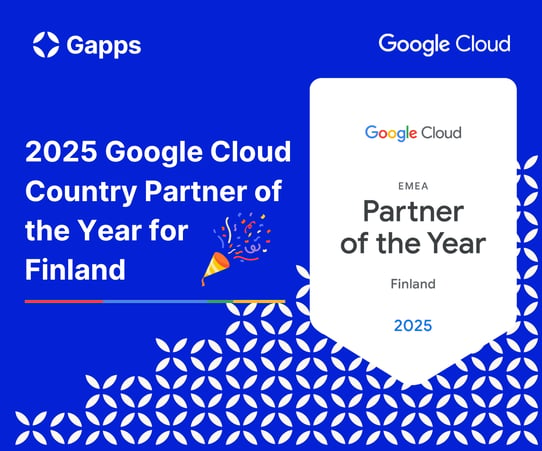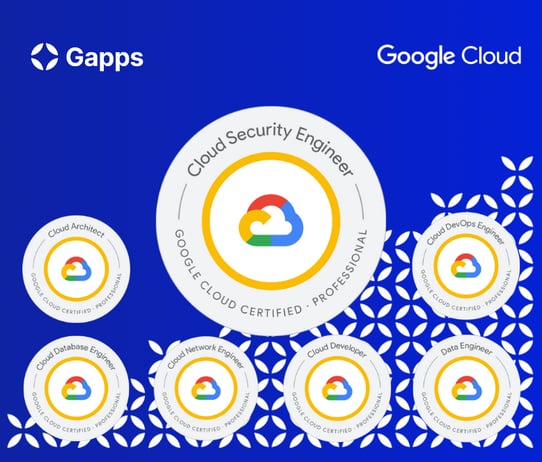AWS, Azure or Google Cloud? Which cloud service is the best?
Let’s delve into the three main platforms and discuss whether it is necessary to choose only one – and whether the choice is ultimately so significant. We will focus on public cloud platforms where companies run their applications and store their data.
Senior Strategic Account Executive, Google Cloud

Cloud services, cloud migration, and cloud strategy have been on the agendas of most Finnish companies in recent years. According to data from Statistics Finland for 2020, 75% of Finnish companies are using cloud services. Cloud services are most widely used in the scientific and technical sectors and the information and communications sectors, in which 95% of enterprises use them.
According to the State of the Cloud Report conducted by Flexera in 2021, companies that have already switched to cloud services measure their success, e.g. cost efficiency/savings (76%), delivery speed of products/services (66%), and cost avoidance (53%). 45% of respondents said that moving to the cloud has increased company’s speed of innovation. While opportunities provided by the cloud are getting more critical for businesses, many ICT decision-makers are fretting over their choice of cloud platform and migration planning.
Three large cloud service providers
In most cases, companies using public cloud services have a choice of three service providers: Amazon, Microsoft and Google. Naturally, other options are available, but let’s focus on AWS, Azure and GCP now. The public cloud market is, in practice, an oligopoly dominated by three big players.
Amazon Web Services
AWS was here first. Amazon’s cloud business was started up in 2006 (depending on how it is calculated), making it the oldest and most established of the competitors. AWS has the largest network of data centres (22 regions and 69 availability zones), the most services (over 200), and it dominates the global market with a market share of 40%. Moreover, it has perhaps the most credible global customers of the three large players, although the others also have some good references.
In principle, AWS provides everything you dream of for ICT service development – from file storage to satellite ground stations. The basic services (EC2 for computing, S3 for storage, and RDS for databases) work well, and the managed service selection provides a large range of pre-supported platforms. The RDS database service supports more databases than any other public cloud service: MySQL, MariaDB, PostgreSQL, OracleDB, MS SQL Server.
If you are wondering whether you could build part of your digital business on AWS, the answer is probably “yes”.
Microsoft Azure
The second-largest public cloud provider in terms of market share is Azure. Since it was rolled out in 2010, it has rapidly eaten away at AWS’s market share. In October 2019, Microsoft snatched a $10 billion cloud service deal with the US Department of Defense (known as the JEDI project) from under AWS’s nose. Azure provides the same basic services as AWS. Even though it is a Microsoft environment, there is nothing stopping customers from running Linux services and Java code. CEO Satya Nadella is driving Microsoft more towards open source.
Azure has gained a strong foothold in Finland in particular, due to Microsoft’s history in the country. Many companies operate a Microsoft legacy architecture – Active Directory, Office tools, and ERP, financial management, and CRM products – making Azure a natural means of transforming their IT environments. In addition, Microsoft has significantly more partners in Finland than AWS or Google, so it is easy for MS customers to find an agile local partner.
Google Cloud Platform (GCP)
GCP is the newest player in the market (2011) and the least well known of the three major cloud service providers. Google is better known for its search engine than its cloud platform. However, it is worth remembering that Google has been developing its internet business for more than 20 years, and it has seven different products and more than a billion users. Over the years, this has forced the company to build a highly efficient and reliable infrastructure for its own purposes, and GCP has since made this infrastructure available to everyone else.
The robust infrastructure enables lightning-fast processing of big data and good artificial intelligence and machine learning services (of the three big players, only Google offers TPUs – dedicated machine-learning hardware – as a service). Google’s BigQuery data warehouse is more efficient and cheaper than its competitors’ EDW solutions. In terms of basic services, GCP’s compute power and database services are less expensive on average than their competitors. For container orchestration, GCP offers Kubernetes as a managed service (Google Kubernetes Engine) at a price 37% lower than AWS and 27% lower than Azure.
Multicloud can make the choice easier
Today, it is no longer necessary to choose a single cloud service provider, as multicloud (aka “polynimbus”) solutions are becoming more commonplace. For example, a company with a strong Azure presence may be interested in GCP for its machine learning interfaces, but this does not necessarily require the entire infrastructure and data to be transferred to Google. A data pipeline and encrypted connection between the clouds can get working together. It is even possible to split the execution of a single application across different cloud services.
The service availability rate is not normally a reason for distributing loads across multiple clouds, but for super-critical software, it is worth bearing in mind. For example, how can you ensure the availability of a game or online store with millions of users if part of the cloud goes completely offline? Amazon’s S3 service went down globally in February 2017, causing large-scale problems for many popular online services. The most common reason for using a multicloud strategy is to avoid becoming dependent on a single service provider.
Services also exist for multicloud management. Anthos, a service launched by Google in spring 2019, offers a portal for the centralised management of GCP, AWS, Azure, and on-premise infrastructure.
Which cloud service should I choose?
Many readers probably get frustrated when articles like this do not offer a definitive answer to the question, “Which cloud service should I choose?” and instead present even more alternatives and advice like “It depends on the circumstances”. However, the simple fact of the matter is that choosing the “wrong cloud service” is not likely to have a catastrophic impact on your business.
Irrespective of the platform, the basic workloads, web applications, and databases can be run efficiently and securely in any cloud. When it comes to higher-level services (such as IoT and data platforms), some significant differences between the power and pricing of the platforms become apparent. These should be evaluated with an expert partner via research and pilot projects.
What you should not do – and this applies to every other aspect of business – is to drive yourself towards vendor lock-in with a single service provider. Amazon, Microsoft and Google seek to increase the attractiveness of their own platforms by offering easy-to-use managed services (such as Elastic Beanstalk, App Service and App Engine). These should be utilised, but caution is required to ensure that your architecture does not become too reliant on a single service provider. The basic approach should be to build the infrastructure so it is easy to transfer. This can be achieved with Docker containers and Infrastructure-as-Code, for example.
As you make your journey towards becoming a cloud-based business, it is a good idea to lean on the help of an expert partner and ensure that your cloud architecture is built in a cost-efficient, scalable, and secure way. Gapps focuses on Google Cloud Platform – you can ask us for help in all matters related to Google’s cloud services.





